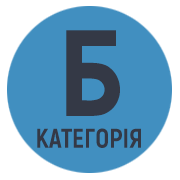MÉREI’S MULTI-ASPECT SOCIOMETRIC METHOD
DOI:
https://doi.org/10.51547/ppp.dp.ua/2022.1.7Keywords:
social relations, grouping, group dynamic, cohesion, sociometry, multi-aspect sociometryAbstract
The presence of peers plays a particularly important role in the lives of schoolchildren, as children spend more and more time in the peer community and gradually learn to develop their place in the group by learning the norms. Thus, the circumstances of grouping, the roles played in social contexts, as well as the experiences and memories of friendships also have a cardinal effect. The primary aim of the present paper is to focus on the potential diagnostic method of Mérei’s multi-aspect sociometry as a method of exploring social relations, based on the review of the related international literature on the topic, and on the presentation of empirical research. Mérei was looking for a different type of sociometry compared to the previous method – one that truly measures the community; one that not only shows the individual’s place in it, but also characterises the community itself, thus allowing the definition of a human association (conglomerate) as a socio-psychological unit. Based on the selection criteria of multi-aspect sociometry, substantial deviations from Moreno’s thesis can be localised. The thesis reflects primarily on the need to interpret not only the social position of the group members, but also on the social position of the formation under study in order to gain an interpretation basis for the small group as a social unit. Secondly, it necessarily incorporates into the characterisation the relations found in the social field, with all its subdivisions, hierarchies and interconnections. Thirdly, it envisages objectives that support the provision of additional information on the motivations, choices and attachments in the social field To correctly manage a group or class, the teacher needs to be aware of the internal dynamics of the group, the deep, hidden events that can provide an important guide in the choice of management techniques. An excellent way to do this is to carry out a sociometric survey. Today, the application of this method is unfairly marginalised in educational-psychological practice, among other things because of its extreme labour-intensity. To counterbalance this, this publication offers an illustrative perspective.
References
Antalóczy, T. Kor-kép. In: (Vész)jelzések a kultúráról. (Eds: Antalóczy, T.- Füstös L.- Hankiss E.). Budapest: L’Harmattan Kiadó, 2009. С. 10–14.
Бергхауер-Олас Е. Л. Кінетичний малюнок школи як можливий метод аналізу соціальних зв’язків. Ідеї гуманної педагогіки та сучасна система інклюзивного навчання : зб. матер. Всеукр. науково-метод. конференції, присвяченої 97-річчю від дня народження В. Сухомлинського. Кіровоград, 2015. С. 29–31.
Бергхауер-Олас Е. Л. Інноваційний метод аналізу соціальних зв’язків – Кінетичний малюнок школи. Роль і місце психології та педагогіки у формуванні сучасної особистості : зб. матер. Міжнародної науково-методичної конференції. Харків, 2016. С. 82–86.
Кочерга О., Васильєв О. Психічне здоров’я молодшого школяра. Психолог на батьківських зборах / упоряд. О. Главник. Київ : Редакції загальнопедагогічних газет, 2003. 112 с.
Mérei, F. Közösségek rejtett hálózata. Budapest : Osiris Kiadó, 2006. 348 с.
Mérei F. A társkapcsolatok megszilárdulása. Csoportlélektani vizsgálatok óvodában. In: Társ és csoport: Tanulmányok a genetikus szociálpszichológia köréből. Budapest : Akadémiai Kiadó, 1989. С. 56–79.
Mérei, F. A szociometria módszerei és jelenségvilága. Szociálpszichológia. Szövegygyűjtemény. (Ed: Lengyel, Zs.). Budapest : Osiris Kiadó. 1997. С. 305–325.
Miller, D. N. – Nickerson, A. B. Projective Assessment and School Psychology: Contemporary Validity Issues and Implications for Practice. The California School Psychologist. 2006. Vol. 11. С. 73–84.
N. Kollár, K. – Szabó, É. Pszichológia pedagógusoknak. Budapest : Osiris Kiadó, 2004. 605 с.
Орбан-Лембрик Л. Е., Орос І. Психолого-педагогічни засади спілкування : монографія / Закарпатський угорський інститут ім. Ференца Ракоці ІІ. Берегове – Ужгород : ТОВ «Рік-У», 2021. 380 с.
Petrusek, M. Szociometria. Budapest : Közgazdasági és Jogi Kiadó, 1972. 362 c.
Piotrowski, C. – Keller, J. W. – Ogawa, T. Projective techniques: An international perspective. Psychological Report. 1993. 72(1). С. 179–182.
Sallay, H., Perge, J. A szociometriai módszer alkalmazása alsó és középfokú oktatási intézményekben. Budapest : ELTE Pedagógiai és Pszichológiai Kar, 2007. 96 c.
Скрипченко О. В., Долинська Л. В., Огороднійчук З. В. Вікова та педагогічна психологія. Київ : Просвіта, 2001. 416 c.
Столяренко Л. Д. Основы психологии: Практикум. Ростов-на-Дону : Феникс, 2006. 672 c.
Золотовицкий Р. А. Социометрия Я. Л. Морено: мера общения. Социологические исследования. 2002. № 4. С. 103–113.
Ядов В. А. Стратегия социологического исследования. Москва : Академкнига, Добросвет, 2003. 596 c.



